Emily Guo
AP Chinese 🇨🇳
53 resourcesSee Units
各种各样的艺术品都可以记录历史。中国的艺术品也不是意外。其实,对于中国的历史,艺术品记录下的场景非常重要。许许多多的重要人物和事件将出现在艺术品中。
History can be recorded by all kinds of art 🎨. Chinese art is no different. In fact, for the history of China 🇨🇳, the scenes recorded by artworks are very important. Many important people and events will appear in the artworks.
📜 Poetry & Songs 🎙️
Throughout history, poems and songs have been an important part of Chinese culture, as well as expressing the history of the times through the meaning behind the poems. Some were used for love, while others were used for ceremonies.
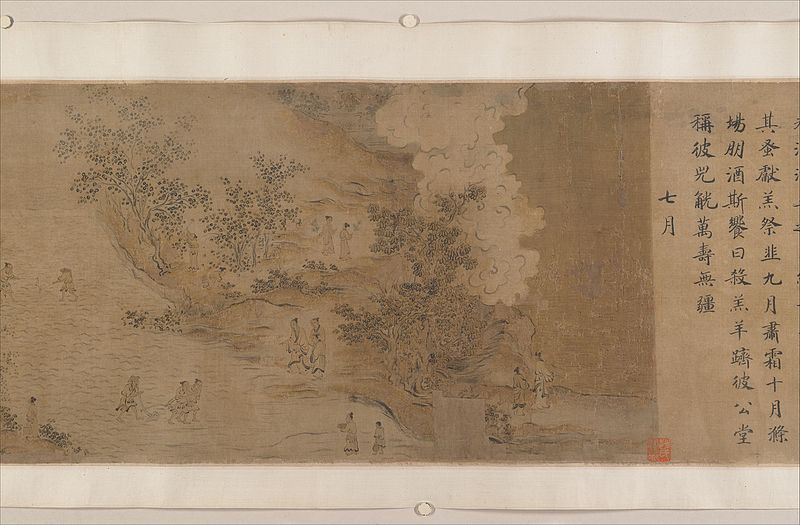
Image Courtesy of Wikimedia Commons
The first book written in China containing poems is called the Book of Songs/Classic of Poetry (诗经(shījīng)). It includes poems written from the 11th century BCE and the 7th century BCE. The first section contains folk songs relating to the stories of common people. The second section contains hymns related to rituals and praising the Zhou dynasty's founders, as well as the feelings of the common people at the time.
Poetry in China 🇨🇳 had its Golden Age during the Tang dynasty (618 CE-907 CE). Poetry was required for the civil service exam, known specifically as the Imperial examination system (科举制度(kējǔ zhìdù)), which were used to choose individual candidates for the bureaucracy.
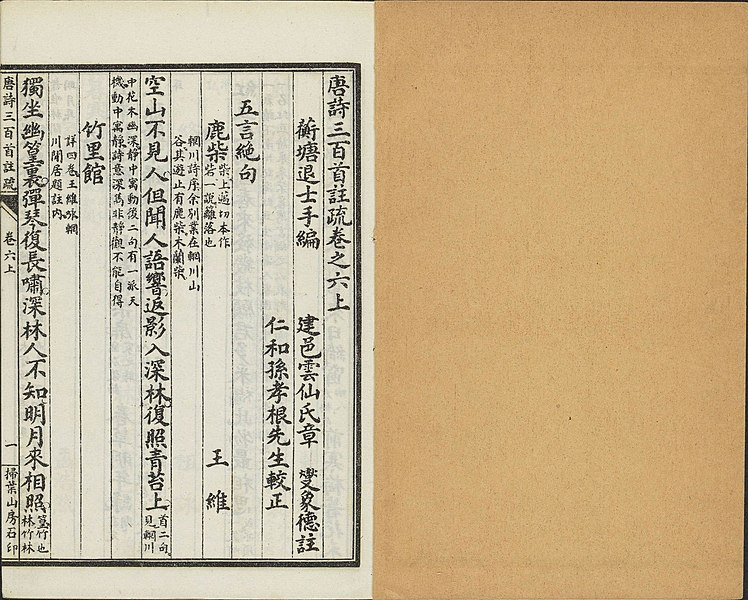
Image Courtesy of Wikimedia Commons
A collection of the most popular poems during the Tang dynasty is called the Three Hundred Tang Poems (唐诗三百首(tángshī sānbǎi shǒu)), as seen above. Commonly seen in modern-day textbooks in China, many of the poems are required to be memorized. Three Hundred Tang Poems have poems about politics, friendship, common life, etc., much like their earlier counterparts.
During the Song dynasty (960 CE-1279 CE), many poems created were based on previous rhythms and tunes, known as Cí(词(cí)). With a total of 800 rhythm forms, Cí poems associated with which rhythm is used. Since military and politics were a common topic throughout life during the dynasty, many poems written during this time reflected that by containing topics pertaining to politics. Other poems, written by those who were unable to be a part of the bureaucracy, reflected thoughts of dissatisfaction with the government.
🖌️ Paintings 🖼️
The evolution of painting, as well as the changes in what is depicted, can record history. In China, the earliest paintings were images of figures and landscapes. Silk paintings, stone paintings, and other lacquer paintings were most common until the invention of paper.

Image Courtesy of Wikimedia Commons
Paintings of landscape became popular and advanced to show 3D effects during the Tang dynasty. Landscape paintings ⛰️🌊 (山水画(shānshuǐhuà)), much like the one shown above, were meant to be depicting feelings and emotions of nature, rather than an accurate depiction of the landscape. Paintings were made using brushes and ink.
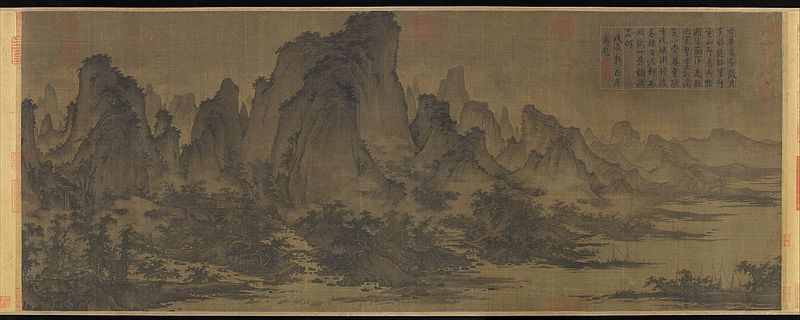
Image Courtesy of Wikimedia Commons
Paintings during the Song dynasty evolved into more faded and blurred images. A large impact was made due to religion: Daoism ☯️ and Buddhism ☸️. During the Northern Song period, many paintings were affected by the politics of the time with large scale reform ideals, causing them to depict large landscapes. The image above is from the Northern Song period.
In comparison, during the Southern Song period, many paintings were influenced by ideals of smaller-scale reforms, causing them to be detailed oriented with the forefront of the painting being the highlight 🔍. Religious aspects from Daoism to Neo-Confucianism shaped this period of change in both political ideals and the paintings made.

Image Courtesy of Wikimedia Commons
During the Yuan dynasty, many paintings 🖼️ began to reflect what the painter felt in the moment, rather than the feelings of the surroundings. Because of the conquest of the Mongols, paintings also began to revert to much older and painting styles to keep a Chinese tradition in lieu of the Mongols presence in China as in the image above.
Many Chinese artists and scholars chose to return to life away from the court because of an unwillingness to participate in the government while it's ruled by outsiders. Many Mongols chose to blend into Chinese culture, therefore not having a large effect on the styles of the paintings, however, more horse 🏇 paintings in hunting and racing appeared due to the nomadic nature of the Mongols.
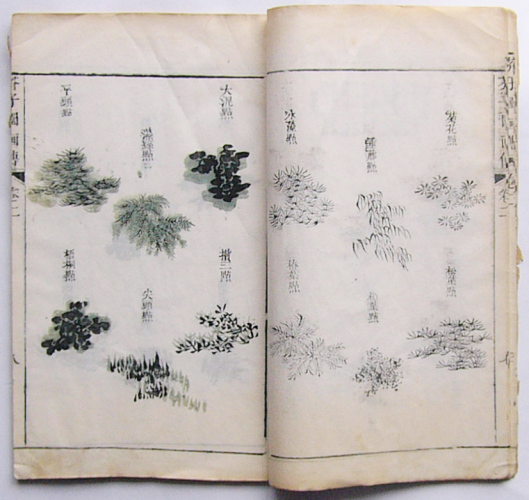
Image Courtesy of Wikimedia Commons
In the Ming dynasty, the colors used in paintings were expanded and specific painted instructions on painting were developed. These instruction manuals are in fact, still in use today. An example is the Manual of the Muster Seed Garden (芥子园画传(jièzǐ yuán huà zhuán)), shown above, which was published in 1679 and contains 5 volumes.
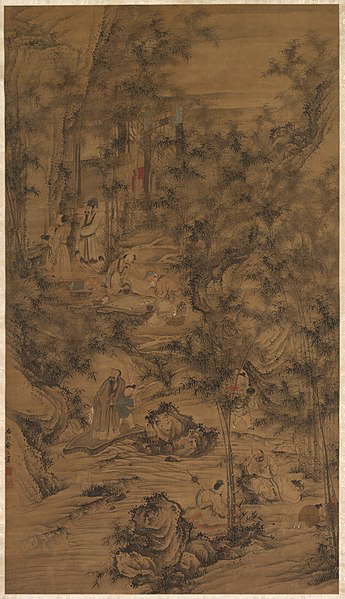
Image Courtesy of Wikimedia Commons
During the Qing dynasty, two painting styles emerged: Orthodox Painting and Individualistic Painting. Both were derived from the theories of 董其昌(dǒngqíchāng). The Orthodox painting style involved mostly recreations of older styles. In comparison, individualistic paintings were made to be purposely different from past styles. The painting above is one made during the Qing dynasty.
Strive for Five Vocab! 🔑🔑
- 诗经(shījīng) - Book of Songs/Classic of Poetry
- 科举制度(kējǔ zhìdù)- Imperial examination system
- 唐诗三百首(tángshī sānbǎi shǒu)- Three Hundred Tang Poems
- 绢画(juàn huà)- Silk Painting
- 石画(shí huà)- Stone Painting
- 漆器(qīqì)- Lacquerware
- 山水画(shānshuǐhuà)- Landscape painting
- 芥子园画传(jièzǐ yuán huà zhuán)- Manual of the Muster Seed Garden
- 毛笔(máobǐ)- Ink Brush
- 墨水(mòshuǐ)- Ink
- 色彩(sècǎi)- Color
Browse Study Guides By Unit
👨👩👧Unit 1 – Families in China
🗣Unit 2 – Language & Culture in China
🎨Unit 3 – Beauty & Art in China
🔬Unit 4 – Science & Technology in China
🏠Unit 5 – Quality of Life in China
💴Unit 6 – Challenges in China
✍️Exam Skills - FRQ/MCQ

Fiveable
Resources
© 2023 Fiveable Inc. All rights reserved.